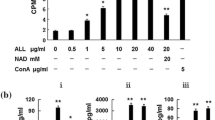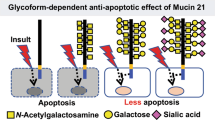Abstract
The present study investigated the mechanism underlying alterations of cell surface sugar chains of Jurkat cells by inducing apoptosis with etoposide, an inhibitor of topoisomerase II. Within 3[emsp4 ]h of etoposide treatment, flowcytometric analysis revealed a decrease in Maackia amurensis agglutinin recognized α2,3-linked sialic acid moieties and an increase in Ricinus communis agglutinin recognized galactose. The results suggested that asialo-sugar chains on glycoconjugates were rapidly induced on the etoposide-treated cell surface. To clarify the desialylation mechanism, we studied α2,3-sialyltransferase mRNA expression and the activity of sialidase on the cell surface during etoposide-induced apoptosis. The expression of hST3Gal III and hST3Gal IV mRNAs were down-regulated and sialidase activity on the cell surface increased threefold within 2[emsp4 ]h of etoposide treatment. Moreover, the decrease in α2,3-linked sialic acid levels was significantly suppressed in the presence of 2,3-dehydro-2-deoxy-N-acetylneuraminic acid, an inhibitor of sialidase. These results suggested that activation or exposure of sialidase on the cell surface was induced by etoposide treatment and was the main cause of the decrease in sialic acids.
Similar content being viewed by others
References
Cohen JJ, Apoptosis, Immunol Today 14, 126–30 (1993).
Morris RG, Hargreaves AD, Duvall E, Wyllie AH, Hormoneinduced cell death. 2. Surface changes in thymocytes undergoing apoptosis, Am J Pathol 115, 426–36 (1984).
Kishimoto H, Surh CD, Sprent JJ, Upregulation of surface markers on dying thymocytes, J Exp Med 181, 649–55 (1995).
Murata T, Yasuda O, Shimada T, Shinomiya T, Yasuno S, Yamaguchi T, Tanuma S, Ikekita M, Structural alteration of cell surface oligosaccharides on HL-60RG cells undergoing apoptosis, Res Commun Biochem Cell Mol 1, 249–62 (1997).
Hakomori S, Igarashi Y, Gangliosides and glycosphingolipids as modulators of cell growth, adhesion, and transmembrane signalling, Adv Lipid Res 25, 147–62 (1993).
Saito M, Bioactive gangliosides: differentiation inducers for hematopoietic cells and their mechanism(s) of actions, Adv Lipid Res 25, 303–27 (1993).
Nagai Y, Functional roles of gangliosides in bio-signaling, Behav Brain Res 66, 99–104 (1995).
Lee YC, Biochemistry of carbohydrate-protein interaction, FASEB J 6, 3193–200 (1992).
Varki A, Sialic acids as ligands in recognition phenomena, FASEB J 11, 248–55 (1997).
Kelm S, Schaufer R, Sialic acids in molecular and cellular interactions, Int Rev Cytol 175, 137–240 (1997).
Kitagawa H, Paulson JC, Differential expression of five sialyltransferase genes in human tissues, J Biol Chem 269, 17872–8 (1994).
Kawaguchi T, Matsumoto I, Osawa T, Studies on hemagglutinins from Maackia amurensis seeds, J Biol Chem 249, 2786–92 (1974).
Kizaki H, Ohnishi Y, Azuma Y, Mizuno Y, Ohsaka F, 1-beta-Darabinosylcytosine and 5-azacytidine induce internucleosomal DNA fragmentation and cell death in thymocytes, Immunopharmacology 25, 19–27 (1993).
Azuma Y, Onishi Y, Sato Y, Kizaki H, Effects of protein tyrosine kinase inhibitors with different modes of action on topoisomerase activity and death of IL-2-dependent CTLL-2 cells, J Biochem 118, 312–8 (1995).
Onishi Y, Azuma Y, Sato Y, Mizuno Y, Tadakuma T, Kizaki H, Topoisomerase inhibitors induce apoptosis in thymocytes, Biochim Biophys Acta 1175, 147–54 (1993).
Taniguchi A, Matsumoto K, Down-reguration of human sialyltransferase gene expression during in vitro human keratinocyte cell line differentiation, Biochem Biophys Res Commun 243, 177–83 (1998).
Naraparaju VR, Yamamoto N, Roles of β-galactosidase of lymphocytes and sialidase of T-lymphocytes in inflammation-primed activation of macrophages, Immunol Lett 43, 143–8 (1994).
Nojiri H, Takatsu F, Tetsuka T, Saito M, Stimulation of sialidase activity during cell differentiation of human promyelocytic leukemia cell line HL-60, Biochem Biophys Res Commun 104, 1239–46 (1982).
Cross AS, Wright DG, Mobilization of sialidase from intracellular stores to the surface of human neutrophils and its role in stimulated adhesion responses of these cells, J Clin Invest 88, 2067–76 (1991).
Kimura Y, Manabe N, Nishihara S, Matsushita H, Tajima C, Wada S, Miyamosto H, Up-regulation of the alpha 2, 6-sialyltransferase messenger ribonucleic acid increases glycoconjugates containing alpha 2, 6-linked sialic acid residues in granulosa cells during follicular atresia of porcine ovaries, Biol Reprod 60, 1475–82 (1999).
Keppler OT, Peter ME, Hinderlich S, Moldenhauer G, Stehling P, Schmitz I, Schwartz-Albiez R, Reutter W, Pawlita M, Differential sialylation of cell surface glycoconjugates in a human B lymphoma cell line regulates susceptibility for CD95 (APO-1/Fas)-mediated apoptosis and for infection by a lymphotropic virus, Glycobiology 9, 557–69 (1999).
Tsuji S, Molecular cloning and functional analysis of sialyltransferases, J Biochem 120, 1–13 (1996).
Miyagi T, Tsuiki S, Rat-liver lysosomal sialidase. Solubilization, substrate specificity and comparison with the cytosolic sialidase, Eur J Biochem 141, 75–81 (1984).
Miyagi T, Tsuiki S, Purification and characterization of cytosolic sialidase from rat liver, J Biol Chem 260, 6710–6 (1985).
Miyagi T, Sagawa J, Konno K, Handa S, Tsuiki S, Biochemical and immunological studies on two distinct ganglioside-hydrolyzing sialidases from the particulate fraction of rat brain, J Biochem 107, 787–93 (1990).
Miyagi T, Wada T, Iwamatsu A, Hata K, Yoshikawa Y, Tokuyama S, Sawada M, Molecular cloning and characterization of a plasma membrane-associated sialidase specific for gangliosides, J Biol Chem 274, 5004–11 (1999).
Martin SJ, Reutelingsperger CP, McGahon AJ, Rader JA, van Schie RC, LaFace DM, Green DR, Early redistribution of plasma membrane phosphatidylserine is a general feature of apoptosis regardless of the initiating stimulus: Inhibition by overexpression of Bcl-2 and Abl, J Exp Med 182, 1545–56 (1995).
Duvall E, Wyllie AH, Morris GM, Macrophage recognition of cells undergoing programmed cell death (apoptosis), Immunology 56, 351–8 (1985).
Hart SP, Haslett C, Dransfield I, Recognition of apoptotic cells by phagocytes, Experientia 52, 950–6 (1996).
Savill J, Fadok V, Henson P, Haslett C, Phagocyte recognition of cells undergoing apoptosis, Immunol Today 14, 131–6 (1993).
Dini L, Autuori F, Lentini A, Oliverio S, Piacentini M, The clearance of apoptotic cells in the liver is madiated by the asialoglycoprotein receptor, FEBS Lett 296, 174–8 (1992).
Author information
Authors and Affiliations
Rights and permissions
About this article
Cite this article
Azuma, Y., Taniguchi, A. & Matsumoto, K. Decrease in cell surface sialic acid in etoposide-treated Jurkat cells and the role of cell surface sialidase. Glycoconj J 17, 301–306 (2000). https://doi.org/10.1023/A:1007165403771
Issue Date:
DOI: https://doi.org/10.1023/A:1007165403771




